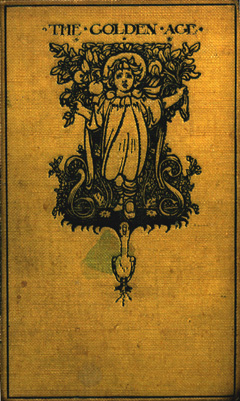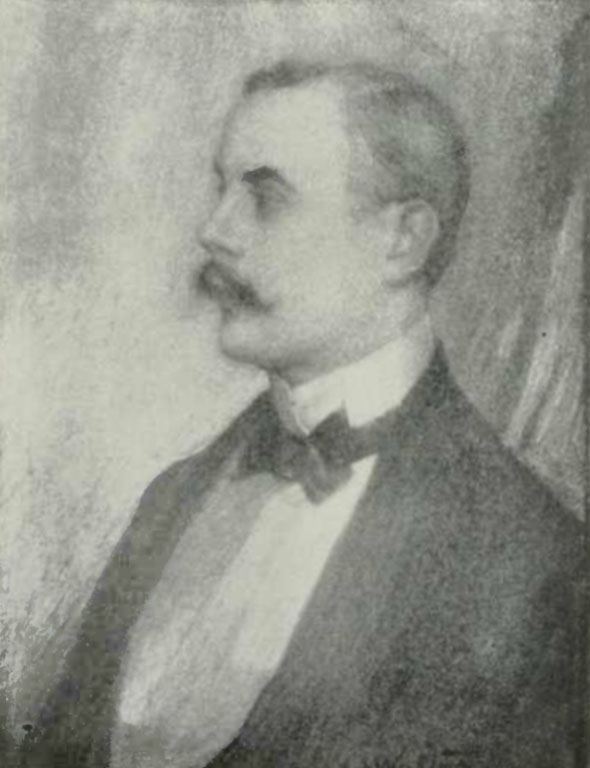Kenneth Grahame
(1859 – 1932)
Kenneth Grahame was born in Edinburgh, Scotland, in 1859. His mother died when he was young and, because his father drank heavily and was therefore unable to care for his children, Grahame and his three siblings were raised by their maternal grandmother at Cookham Dene, England. These early years on the shores of the Thames provided lasting inspiration for the author’s essays and fiction.
Grahame was educated at St. Edward’s School, Oxford. Though he clearly longed to spend his life immersed in tranquil studies at the University of Oxford, in 1878 limited finances obliged him to move to London and take a post with the Bank of England.
The extent to which Grahame’s spirit chafed at the din and congestion of the imperial metropolis is clear in his first recorded publication, the prose sketch “By a Northern Furrow,” which appeared in the St. James’s Gazette in 1888. It is also powerfully manifested in his first collection of essays, Pagan Papers (1893), the frontispiece of which Aubrey Beardsley (1872-1898) designed. Deeply influenced by the work of Robert Louis Stevenson (1850-1894), Pagan Papers’ nostalgic vignettes celebrate the lingering remnants of ancient modes of life and acknowledge that those essential elements will soon be tarred over by crass modern progress.
Pagan Papers was published by John Lane (1854-1925) at The Bodley Head and, a year later, Grahame showed up for the first time in Lane’s Yellow Book. The fin de siècle was, in fact, Grahame’s most productive literary period. In addition to publishing pieces in The Yellow Book , National Observer, and St. James’s Gazette, his story collections The Golden Age (1895) and Dream Days (1898) — both issued by Lane — were met with considerable acclaim. In all three of his 1890s volumes, there is a clear stylistic affinity with the decade’s jaundiced hues:
“Summers sicken, flowers fail and die, all beauty but rides round the ring and out at the portal” (Dream Days).
Grahame married Elspeth Thomson (1862-1946) in 1899, a relationship that reputedly brought neither person much happiness.
In 1908, through a combination of ill health and financial ease, Grahame was at last able to retire from the Bank of England and return to his beloved upper Thames. That year also saw the publication of The Wind in the Willows , a book that began as a series of bedtime stories for and letters to his only child, Alastair (affectionately known as Mouse).

In 1916 Grahame edited The Cambridge Book of Poetry for Children. From that point onward, however, the rest is almost utter silence, as Mouse’s untimely death in 1920 appears to have broken Grahame’s spirit and stifled his creative drive. In 1932 Grahame passed away at his home in Pangbourne and was buried in a quiet Oxford churchyard.
© 2010, Morgan Holmes
Morgan Holmes holds a PhD in English from McGill University. The director of WordMeridian Communications in Toronto, his research and publication focus on early modern literature and culture, Victorian/Edwardian history, and current developments in post-secondary education and health-care policies and service delivery.
Selected Publications by Grahame
- “Dies Iræ.” The Yellow Book, Vol. 8 (Jan. 1896): 101-11.
- Dream Days. London: John Lane at the Bodley Head, 1898.
- “A Falling Out.” The Yellow Book, Vol. 4 (Jan. 1895): 195-201.
- The Golden Age. London: John Lane at the Bodley Head, 1895.
- “The Headswoman.” The Yellow Book, Vol. 3 (Oct. 1894): 25-47.
- “The Iniquity of Oblivion.” The Yellow Book, Vol. 7 (Oct. 1895): 192-99.
- “The Inner Ear.” The Yellow Book, Vol. 5 (April 1895): 73-76.
- Introduction. The Cambridge Book of Poetry for Children . Ed. Kenneth Grahame. New York: G.P. Putnam’s Sons, 1916.
- Introduction. The Cambridge Book of Poetry for Children . Ed. Kenneth Grahame. New York: G.P. Putnam’s Sons, 1916.
- Introduction. The Cambridge Book of Poetry for Children . By George Sanger. London: J.M. Dent, 1926.
- Introduction. The Cambridge Book of Poetry for Children . By George Sanger. London: J.M. Dent, 1926.
- Introduction. Gazette. Ed. Kenneth Grahame. New York: G.P. Putnam’s Sons, 1916.
- Introduction. Seventy Years a Showman. By George Sanger. London: J.M. Dent, 1926.
- “Long Odds.” The Yellow Book, Vol. 6 (July 1895): 78-86.
- Pagan Papers. London: John Lane at The Bodley Head, 1893.
- “The Roman Road.” The Yellow Book, Vol. 2 (July 1894): 211-19.
- “To Rollo.” The Yellow Book, Vol. 12 (Jan. 1897): 165-66. [Poem.]
- The Wind in the Willows. New York: C. Scribner’s & Sons, 1908.
Selected Publications about Grahame
- Chalmers, Patrick Reginald. Kenneth Grahame: Life, Letters and Unpublished Work . London: Methuen, 1933.
- Graham, Eleanor. Kenneth Grahame. London: Bodley Head, 1963.
- Green, Peter. Kenneth Grahame: A Biography. London: John Murray, 1959.
- Kuznets, Lois R. Kenneth Grahame. Boston: Twayne, 1987.
- Prince, Alison. Kenneth Grahame: An Innocent in the Wild Wood . London: Alison & Busby, 1994.
MLA citation:
Holmes, Morgan. “Kenneth Grahame (1859-1932),” Y90s Biographies , 2010. Yellow Nineties 2.0, edited by Lorraine Janzen Kooistra, Ryerson University Centre for Digital Humanities, 2019, https://1890s.ca/grahame_bio/.
